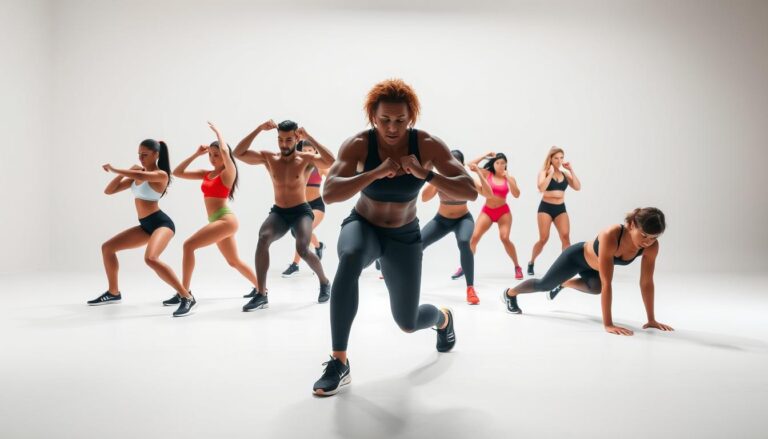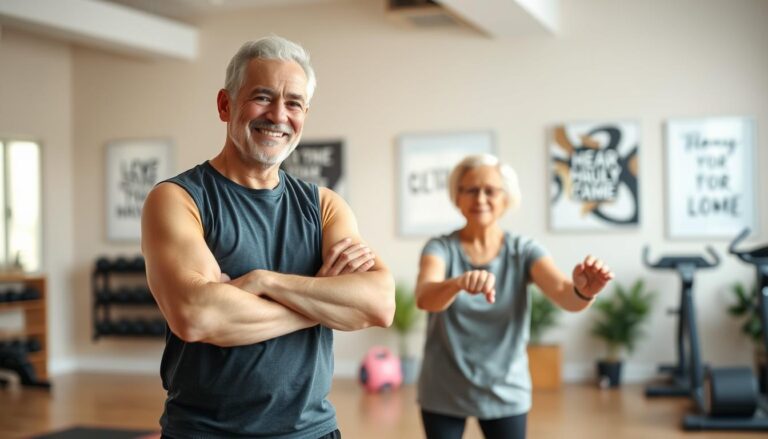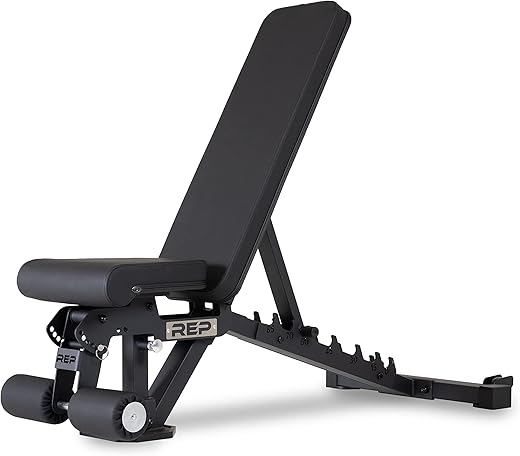Crafting the Perfect Home Gym: Top Tips for Exercise
Busy lives make it hard to find time for fitness. But, what if you could have a gym right at home? Setting up a home gym setup is a smart way to stay fit without going to the gym.
A home gym gives you a comfy and private place to work out. It changes how you exercise for the better. It saves time, boosts motivation, and lets you tailor your workouts to your needs. It’s great for those with tight schedules, helping you stick to your exercise plan.
By investing in a well-planned home gym, you take charge of your fitness. It makes reaching your health goals easier.
Key Takeaways
- Create a dedicated workout space at home for a more personalized experience.
- Save time by avoiding commute to traditional gyms.
- Increase motivation with a private and comfortable workout environment.
- Customize your home gym to fit your specific fitness needs.
- Enjoy the convenience of working out at any time.
Why Building a Home Gym Makes Sense
Building a home gym is a smart choice for those who value their time, money, and comfort. It offers a convenient, cost-effective, and personalized workout space. This can greatly impact your fitness journey.
Time and Cost Benefits
Having a home gym saves you time and money. You don’t have to commute to a gym. This saves both time and money on gym memberships and travel.
Eliminating Commute and Membership Fees
With a home gym setup, you avoid monthly gym fees. You also save time that you can use for more workouts or other activities.
Long-Term Financial Advantages
The initial cost of a home gym may seem high. But, it’s cost-effective in the long run. You save a lot of money on gym memberships and travel costs over time. This makes a budget-friendly home gym a smart financial choice.
Convenience and Privacy Advantages
A home gym lets you work out anytime. You’re not tied to a gym’s hours. This is great for those with busy schedules or non-traditional work hours.
24/7 Availability
With a home gym, you can work out whenever you want. Whether it’s early morning, late at night, or during lunch. This efficient home gym design lets you create a workout routine that fits your life.
Personalized Workout Environment
A home gym is your own private space for workouts. You can make it fit your needs and preferences. This makes your workouts more enjoyable and effective.
Assessing Your Available Space
Setting up a home gym starts with checking the space you have. You need to see if it fits your workout needs. Look at the size, layout, and other things that might change your workout.
Measuring and Evaluating Potential Areas
To make a good home workout space, measure and check the areas in your home. Think about the room’s size, where the doors are, and any things that might get in the way of your workout.
Minimum Space Requirements
The space you need for a home gym depends on the equipment you want. For example, a simple setup with a yoga mat and weights needs less room than a gym with a treadmill and a bench.
Multi-Purpose Room Considerations
If you’re using a room for both your gym and other things, think about how to use space well. Use equipment that saves space and design a layout that works for different activities.
Considering Ceiling Height and Flooring
When looking at your space, don’t forget about the ceiling height and flooring. These can really affect your workout and the equipment you can use.
Overhead Clearance Needs
Make sure you have enough room above you for lifting weights or using tall equipment.
Appropriate Flooring Options
Pick flooring that’s right for your gym, like rubber or foam tiles. They help protect your equipment and make your workouts safer.
Determining Your Fitness Goals and Needs
The first step in building a successful home gym is to know what you want to achieve. Understanding your fitness goals is key to creating a space that meets your needs.
Strength Training vs. Cardio Focus
Different fitness goals need different approaches. If you focus on strength training, you’ll need dumbbells, barbells, and a bench. For cardio, a treadmill, stationary bike, or rowing machine might be better.
Equipment Needs for Different Goals
For strength training, think about a power rack or squat stand. For cardio, a compact elliptical trainer or a HIIT kit could be good.
Balancing Multiple Objectives
Many people have more than one fitness goal. It’s important to find a balance. This means allocating space and budget for the right equipment for each goal.
Specialized Training Requirements
Some fitness goals need special equipment. For example, athletes may need sport-specific equipment to get better.
Sport-Specific Equipment
Athletes training for specific sports might need unique gear. This could include agility ladders or plyometric boxes.
Rehabilitation and Mobility Considerations
Those recovering from injuries or with mobility issues can benefit from certain equipment. Resistance bands or a yoga mat can be helpful.
Top Tips for Building a Gym for Exercise at Home
A well-designed home gym is key for a great workout. To make it happen, you need to think about a few important things.
Planning for Efficient Workflow
Creating a smooth workout flow is all about planning. You want to move easily between exercises and avoid distractions. This means thinking carefully about how you lay out your space.
Creating Zones for Different Activities
Divide your gym into zones for better organization. This makes your workouts more efficient. You can have areas for cardio, strength, and recovery.
Safety Considerations
Safety is crucial when setting up your gym. Make sure there’s enough room around equipment and plan for emergencies.
Equipment Spacing and Clearance
Make sure there’s enough space around each piece of equipment. Avoid overcrowding to keep your gym safe.
Emergency Access and First Aid
Make sure you can get out quickly and have a first aid kit ready. Being ready for emergencies is important for a safe gym.
Essential Equipment for Beginners
For those new to working out at home, finding the essential home gym equipment is key. The right gear can greatly improve your workouts and fitness journey.
Versatile Starter Equipment
Start with versatile equipment for various exercises. This saves space and money.
Resistance Bands and Adjustable Dumbbells
Resistance bands are light, easy to carry, and work many muscles. Adjustable dumbbells are great because they offer different weights in one.
Multi-Function Benches
A multi-function bench supports many exercises. It’s a must-have for any home gym.
Space-Saving Options
For small spaces, there are DIY home gym ideas and space-saving options.
Foldable and Storable Equipment
Foldable and storable equipment is perfect for small areas. It keeps your space tidy and free for workouts.
Wall-Mounted Solutions
Wall-mounted solutions save space. They keep your gear organized and out of the way.
Quality vs. Cost Considerations
Choosing between quality vs. cost is crucial. Cheaper options might seem good but can cost more in the long run.
Where to Invest and Where to Save
Invest in durable items like dumbbells. Save on less critical items like resistance bands.
Durability Factors
Think about equipment durability. Better materials and build cost more but last longer, saving money over time.
Advanced Equipment Options for Serious Enthusiasts
Serious enthusiasts can really boost their workouts with advanced gear in their home gym setup.
Strength Training Equipment
There are many advanced tools for strength training.
Power Racks and Cable Machines
Power racks are safe for lifting heavy. Cable machines let you do many exercises.
Free Weight Collections
A good free weight collection has dumbbells, kettlebells, and barbells. They’re great for many strength exercises.
Cardio Machines Worth the Investment
Cardio lovers should get the right gear for better workouts.
Treadmills and Ellipticals
Treadmills and ellipticals are top picks for cardio. They’re easy on the joints and boost heart health.
Rowing Machines and Stationary Bikes
Rowing machines work your whole body. Stationary bikes focus on legs and heart health.
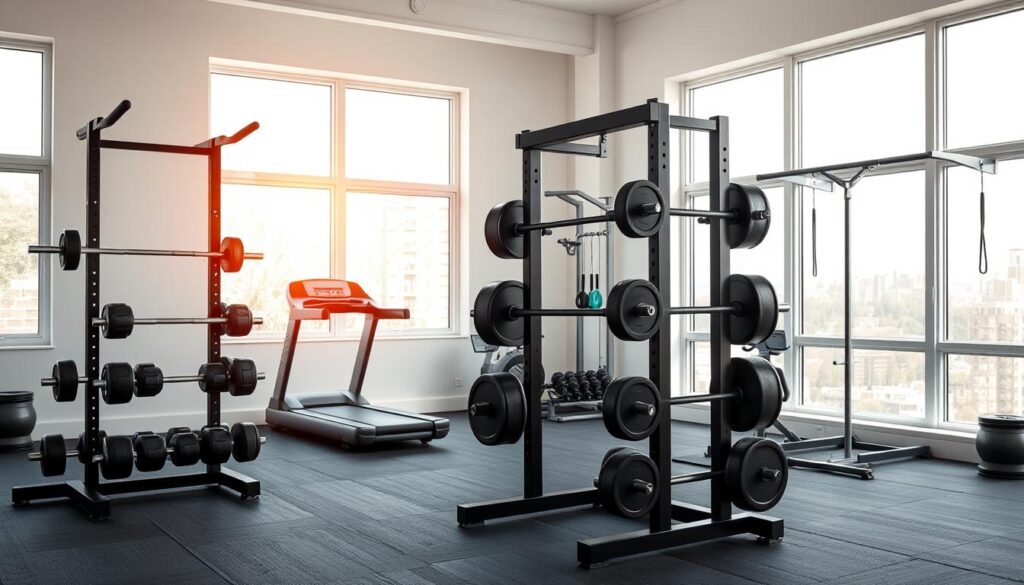
Specialty Equipment for Specific Goals
Some people have special fitness goals that need special gear.
Olympic Lifting Gear
For Olympic lifting, you need special gear like Olympic barbells and platforms.
Functional Training Tools
Functional training tools like battle ropes and suspension trainers add variety. They also boost fitness.
Adding these advanced tools to your home gym setup makes it efficient. It supports your fitness goals and uses your space well.
Budget-Friendly Home Gym Solutions
You don’t have to spend a lot to set up a home gym. You can make a great workout space with creativity, resourcefulness, and planning.
DIY Equipment Alternatives
Using DIY equipment is a smart way to save money. It lets you tailor your gym to fit your needs perfectly.
Homemade Weights and Racks
You can make your own weights from concrete, steel pipes, and water containers. For example, fill old water bottles with sand or concrete for dumbbells. A weight rack can be made from metal pipes or reclaimed wood.
Repurposed Household Items
Many household items can be used as gym equipment. A sturdy chair can be for step-ups or tricep dips. Resistance bands are great for strength training.
Finding Quality Used Equipment
Buying used equipment is another cost-effective option. It can save you money while still getting good quality.
What to Look For When Buying Used
When buying used, check for wear and tear. Look for damage, ensure all parts work, and test it if you can.
Best Sources for Second-Hand Gear
Online sites like Craigslist, eBay, and Facebook Marketplace are good for used gym gear. Local thrift stores, garage sales, and gym closures also offer great deals.
Prioritizing Purchases for Maximum Value
To get the most value, focus on what you need for your fitness goals.
Essential First Buys
Start with basics like a good yoga mat, resistance bands, or dumbbells. These items are versatile and useful for many exercises.
Gradual Expansion Strategy
As you get better, add more specialized equipment. This way, you spread out the cost over time.
With these budget-friendly tips, you can have a great home gym without spending too much. DIY projects, used equipment, and smart buying can help you reach your fitness goals without breaking the bank.
Optimizing Your Home Gym Layout
Improving your home gym layout can greatly enhance your workout. A well-organized space is key for a great exercise session.
Space-Efficient Arrangements
To make the most of your home workout space, think about space-saving ideas. You can:
- Choose compact equipment
- Pick machines that do more than one thing
- Plan your room’s layout carefully
Vertical Storage Solutions
Using vertical storage solutions keeps your gear organized and your floor free. Think about wall-mounted racks or shelves for storing your equipment.
Multi-Use Area Planning
Creating a multi-use area maximizes your space. You can turn your gym into a home office or living room too.
Storage Solutions for Equipment
Good storage keeps your gym tidy. Here are some ideas:
- Wall-Mounted Racks and Shelving: Great for storing dumbbells, resistance bands, and yoga mats.
- Mobile Storage Options: Handy for big equipment or a flexible workout area.
Lighting and Ventilation Considerations
Right lighting and ventilation make your gym comfy. Think about these:
- Natural vs. Artificial Light: Use natural light when you can, and good artificial light for evening workouts.
- Air Circulation and Temperature Control: Good air flow and a comfy temperature boost your workout.
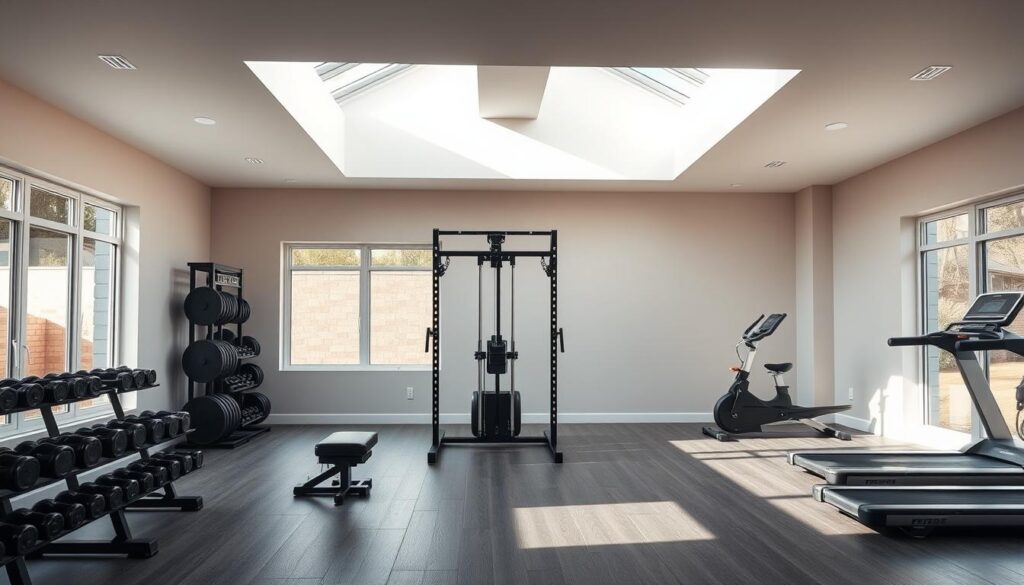
Creating a Motivating Atmosphere
Your home gym’s atmosphere is key to your workout motivation. It’s not just about looks; it’s about creating a space that boosts productivity and energy.
Décor and Color Psychology
The look and colors of your gym can really affect your motivation. Different colors can make you feel different ways.
Energizing Color Schemes
Red, orange, and yellow can energize your workouts. Use these colors in your gym’s design through walls, equipment, or accessories.
Mirrors and Visual Elements
Mirrors make your gym look bigger and help you check your form. Adding motivational quotes or posters can also make it more appealing and motivating.
- Use mirrors to make your gym look bigger.
- Put up motivational quotes to lift your spirits.
- Add plants to improve the atmosphere.
Audio and Visual Setup
A good audio and visual setup can make your workouts better. This includes a quality sound system and a screen for videos or streaming.
Sound System Considerations
A good sound system can keep you pumped with your favorite music. Look for one that’s easy to use and sounds great.
Screen Placement for Workout Videos
Having a screen at the right height and distance can improve your workout. Make sure it’s securely mounted to avoid accidents.
- Choose a screen size that fits your space.
- Ensure the screen is at a comfortable viewing height.
- Look for a screen with good brightness and resolution.
Incorporating Inspirational Elements
Adding things that inspire you can make your workouts more fun and motivating. This could be through goal tracking or personal motivation features.
Goal Tracking Displays
Seeing your progress can be a big motivator. Consider a display or board to track your goals and achievements.
Personalized Motivation Features
Make your gym personal with things that motivate you, like favorite quotes or photos. This can make your workouts more enjoyable.
For more tips on setting up your home gym, visit our guide on how to set up a home.
Technology Integration for Modern Home Gyms
Technology is changing home gyms with new tools and features. It brings smart fitness equipment, fitness apps, and virtual reality. These make workouts more fun and effective at home.
Smart Fitness Equipment
Smart fitness equipment is making home gyms better. It includes connected machines that track workouts and offer virtual training. This helps users stay motivated and see their progress.
Fitness Apps and Digital Coaching
Fitness apps and digital coaching are key for modern home gyms. They offer tools for workout planning and tracking progress. This helps users reach their fitness goals.
Virtual Reality and Immersive Experiences
Virtual reality (VR) and immersive experiences are new in home gym tech. They bring VR fitness apps and interactive systems. These make exercising more fun and engaging.
Conclusion: Enjoying the Benefits of Your Perfect Home Gym
Having a well-planned home gym lets you enjoy a consistent workout routine. By following top tips, you can make a space that fits your needs and goals.
A good home gym setup means you can work out at home, saving time and money. It helps you stay motivated and focused on your fitness goals.
With the right equipment, layout, and atmosphere, your home gym will support your fitness journey. Start building your perfect home gym today. Experience the benefits of a consistent and effective workout routine.

